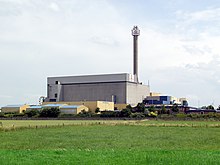SNR-300


The SNR-300 was a
Background
In
in 1968, which was powered up in December 1973. It was a pool-type liquid-metal fast breeder reactor cooled with liquidWhen the project for the subsequent full-scale power-plant prototype Superphénix was started in 1986, it was generally felt that no more experimental FBT prototypes were needed. Superphénix, being a prototype reactor, demonstrated reliability issues and had a historical capacity factor of less than 14.4%.[2] Many of these problems were solved over time, and by 1996 the prototype was reaching its design operational goals.
The Russian
Planning
In late 1972, Germany, Belgium and the Netherlands charged the
On 20 May 1975, the
Timeline
- 1972: The project commences.
- April 25, 1973: foundation stone ceremony
- 1977: Increasing public doubt about the safety of nuclear energy culminates in the first demonstration, involving about 40,000 people marching in the streets of Kalkar.
- March 28, 1979: Three Mile Island suffers a partial meltdown and a local anti-nuclear movement causes open questioning of the project. This discussion leads to an inquiry by a commission of the Bundestag. Building is interrupted for 4 years as the commission concludes that the safety of the facility needs to be upgraded in light of the difficult to control process of fast breeders, along with concerns about the coolant (sodium, which can explode when in contact with water). The interruption along with the redesign of the safety features raise the costs of the project significantly. The local state government of North Rhine-Westphalia turns against the project.
- 1982: The Federal Chancellor of the Federal Republic of Germany Helmut Schmidt (SPD) is followed by Helmut Kohl(CDU).
- 1985: SNR-300 is completed. The reactor is taken into partial operation. The Bundestagswahl 25 January 1987), the German government unofficially decides not to take SNR-300 into operation just yet.
At this point neither the country government, nor the local state government (MP from 1978 to 1998 was Johannes Rau) want the facility to become operational. Plans for a second facility, SNR-2, planned to produce 1,500 megawatts, are officially cancelled around this time.
- 26 April 1986: Chernobyl disaster.
- 1991: The official cancellation of the SNR-300 is offered on 21 March. The demolition of parts of the facility costs another 75 million euros. The unused machinery is put on sale. The reactor core is transferred to storage elsewhere. The breeder material, already bought for the operation of the facility, is transferred to France where it is mixed into MOX fuel, which is used by a number of France's nuclear reactors.
- early 1990s: 12 unused blanket fuel assemblies from SNR-300, containing depleted uranium, were transferred to James Acord and housed at Hanford Nuclear Reservation.[5]
- 1995: The facility is put up for auction by way of an announcement in the newspapers. The Dutch investor/developer Hennie van der Most buys the property for 2.5 million euros. The site is transformed into an amusement park named Kernwasser Wunderland ("Nuclear water Wonderland"). It includes a hotel with 400 beds. In 2005 it was renamed into Wunderland Kalkar ("Wonderland Kalkar").
References
- ^ "Planned fast sodium-cooled reactor in Kalkar/Rhine, with an electric gross output of 327 MW. After being almost totally completed, the reactor did not enter service for political reasons;from google (snr 300 sodium cooled) result 6". Archived from the original on 2016-12-01. Retrieved 2016-12-01.
- ^ "PRIS - Reactor Details". pris.iaea.org. Retrieved 2021-05-13.
- ^ 75/328/Euratom: Council Decision of 20 May 1975 on the establishment of the Joint Undertaking 'Schnell-Brüter- Kernkraftwerksgesellschaft mbH' (SBK), 1975-06-12, retrieved 2019-11-03
- ^ "SNR-300". memim.com. Retrieved 2021-12-06.
- ^ "Archived copy" (PDF). Archived from the original (PDF) on 2015-06-11. Retrieved 2012-02-14.
{{cite web}}: CS1 maint: archived copy as title (link)
